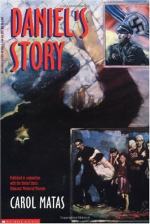|
This section contains 923 words (approx. 3 pages at 400 words per page) |

|
Daniel's Story Summary & Study Guide Description
Daniel's Story Summary & Study Guide includes comprehensive information and analysis to help you understand the book. This study guide contains the following sections:
This detailed literature summary also contains Topics for Discussion on Daniel's Story by Carol Matas.
Daniel’s Story is a story of death and survival, of desperation and hope, evil and love. The story is told from Daniel’s point of view as he experiences the atrocities of the holocaust for Jews in central Europe. When the story opens, he is 14 years old, riding on a train and looking at pictures in his photo album. Daniel uses a photograph album to spark his memory of events from when he was six years old until the day he and his family are loaded onto the train bound for the Lodz ghetto.
After spending two and a half years in the ghetto, Daniel is again riding on a train, this time to Auschwitz labor/death camp and he has a few pictures with him that tell the story of his time in the ghetto. He took pictures of people to try and earn money; he met other youth who tried to find places for people who were being transported out to hide, and they tried to survive. Disease, starvation, cold and fear are daily, even hourly, concerns for Daniel, his family and friends. He watches as families are separated, babies are killed and old people are left to freeze to death. Just as he shows signs of despair, something - his sister’s violin playing, or being involved with the Youth Group - gives him new hope for survival.
Upon arrival at Auschwitz, Daniel and his father are separated from his mother and sister, and the horrors of the camp are described. From being shaved and disinfected to watching other prisoners being shot point blank for no reason, Daniel continues to push through with his desire to live and be reunited with Rosa. His father is his constant companion and they are able to see Erika, Daniel’s sister for brief moments on their way to the work barracks. He is recruited by a friend from the Lodz Youth Group to join the resistance group. He will take pictures of the crematoriums and the body pits. The pictures will be smuggled out to show the allied forces what is really happening in the camp. Daniel feels good to be involved with the resistance effort. As the allied troops move closer to the camp, the selections and killings increase and finally Daniel and his father are transported out of the camp, once again they are on a train headed for Buchenwald, the pictures of Auschwitz are now only in his head.
Once at Buchenwald, Daniel experiences again the shaving and disinfection, but this time there is a brief respite in the torture. They are forced into quarantine for three weeks where they are not allowed to work with the regular camp population. They are also given, for the first time, some warm clothes. But then the work starts. The lack of food and torture continues, although this is not strictly a killing camp but more of a work camp. Daniel’s job is to help a photographer. He will take pictures of Nazi officers and their families. It is while doing his job that he meets one particular officer who is attentive and loving toward his wife and two daughters who later shoots a young boy in the leg for not sweeping the walkway correctly. The officer eventually kills the boy as Daniel looks on. Daniel finds solace in his father’s company but cannot understand how his father’s religious convictions are strengthened through these experiences while his own are faltering.
Daniel is so upset by the murder of the child, that he unconsciously tells his photographer friend that he used to work for the resistance while in Auschwitz. He is recruited, along with his father to help with the resistance at Buchenwald. They have a radio and know that the allies are approaching.
When the time comes, Daniel and his father are given guns and are stationed by a gate. They shoot two guards. One is killed but the other is not, and while Daniel wants to shoot him, his father tells him no, to do that would be to stoop to their level of evil and he will not be like they are. Daniel lets him live. They spend a few weeks at the camp and are careful after the allies arrive not to eat too much too fast and get sick.
Daniel rides the train one last time. This time he is in a seat, not a freight car and some pictures are in his hand, while others are in his head. He reviews those events of Buchenwald while looking forward to meeting Rosa at his old apartment in Lodz as they had promised. When he gets to Lodz, things have changed so at first he has a difficult time finding his way around. Once he gets into the ghetto area, he knows where he is and approaches the street he lived on. There in front of his apartment is Rosa. She comes to meet him, and they both have changed in their looks so they hardly recognize each other. But, their love has not changed. Rosa tells Daniel of his sister: she made it out of the camp; she was determined to be liberated, but was so weak and ill, Rosa was with her when she died.
Daniel and Rosa are together. He feels lucky to be with her after all the horror he lived through and they vow to remember, to never forget lest they be defenseless again, against such evil.
Read more from the Study Guide
|
This section contains 923 words (approx. 3 pages at 400 words per page) |

|



